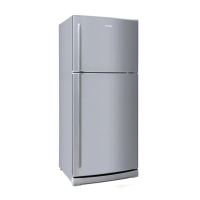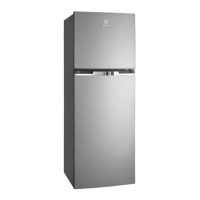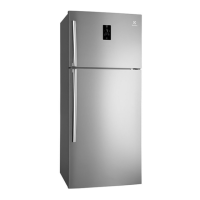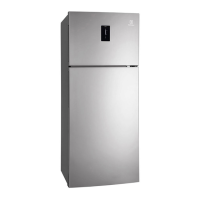Do you have a question about the Electrolux ETM5200 and is the answer not in the manual?
Explanation of symbols used in the manual to indicate safety, damage avoidance, tips, and environmental information.
Specifies the intended household and similar applications for the appliance.
Guidelines for recycling and disposing of the appliance and its materials environmentally.
Precautions regarding the use of flammable R600a refrigerant to avoid safety hazards.
Steps for switching off the appliance for extended periods to prevent mold growth.
Checks and precautions for safe electrical connection and use of the appliance.
Advice on selecting a suitable location, avoiding extreme temperatures and humidity for optimal performance.
Lists items and actions to avoid, such as storing explosive substances or attempting self-repair.
Recommended airspace for proper ventilation, including specific clearances for different model types.
Guidance on tilting the refrigerator back for self-closing doors and adjusting front rollers.
How to check and adjust refrigerator level using rollers or packing for uneven floors.
Instructions for winding the stability foot down to secure the appliance and winding it up for movement.
Advice on final cleaning, direct power connection, and initial run checks.
Explanation of typical sounds like compressor noise, air movement, and gurgling during operation.
Advice on not blocking air vents and preventing frost by ensuring proper door closure.
Description of the LCD display, touch buttons, and auto-off feature.
Recommendations for setting initial temperatures and adjusting them gradually for optimal cooling.
How to use the fast freeze function for rapid freezing and its duration.
What the freezer temperature alarm indicates and how to reset it.
Explanation of the door alarm functionality and how to temporarily disable it.
Instructions on activating and deactivating the child lock feature to prevent setting changes.
How to use the drinks chill timer for rapid beverage cooling in the freezer.
Overview of Eco, Normal, and Vacation modes for energy saving and optimal operation.
How to activate vacation mode for energy saving during long absences.
Features like independent compressor/fan control and automatic defrost for electronic models.
General advice on setting temperatures using rotary controls and tips for optimal settings.
Specific instructions for adjusting the freezer temperature using the top knob on TM models.
Specific instructions for adjusting the refrigerator temperature using the bottom knob on TM models.
Instructions for adjusting the refrigerator temperature using the top knob on BM models.
Instructions for adjusting the freezer temperature using the bottom knob on BM models.
How to adjust temperature using rotary controls on AR and built-in refrigerator models.
How to adjust temperature using rotary controls on AF and built-in freezer models.
How to use the crisper bin for storing vegetables and fruit, and adjusting humidity control.
Tips for storing vegetables in the crisper bin with high humidity setting.
Tips for storing fruit and small goods in the crisper bin with low humidity setting.
Step-by-step guide on how to remove standard crisper bins and shelves.
Instructions for removing bins that use telescopic extension slides.
Guide on how to correctly reinsert bins with telescopic extension slides into the refrigerator.
Information on removable and adjustable door storage bins for various models.
Use of the dairy compartment for butter, cheese, and its temperature characteristics.
Guidance on using the chiller bin for specific foods and its odor-preventing properties.
Description of the bottle caddy and how to store bottles correctly.
Features of freezer baskets in built-in models, designed for visibility and easy access.
Instructions for removing and reinserting freezer drawers mounted on telescopic slides.
Features of Spillsafe™ shelves, including spill retention and adjustability.
Method for repositioning shelves within the appliance for better access or to accommodate items.
How to collapse the slide-away glass shelf to half depth for storing tall items.
Explanation of the deodoriser's function in removing food odours and tips to enhance its effectiveness.
How to use the bottle twist holder in horizontal and vertical positions to secure bottles.
Instructions for using the twist ice & serve ice cube tray assembly.
Steps for mounting the twist & serve ice assembly in a different freezer location.
Detailed steps for safely replacing the light bulb in manual control models.
Information about LED lighting, its lifespan, and dimming/turn-off behavior.
General safety precautions and advice before cleaning the appliance.
Specific cleaning instructions for stainless steel surfaces, emphasizing wiping with the grain.
Cleaning guidelines for acrylic doors, warning against harsh chemicals.
How to clean the appliance interior, including handling removable parts and avoiding steam cleaners.
Advice on cleaning door seals to prevent sticking and tearing.
Checks to perform if the refrigerator is not working, including power and temperature settings.
Explanation of normal operational sounds and potential causes of unusual noises.
Possible causes of odours and simple checks to identify the source.
Troubleshooting steps for unresponsive electronic controls, including delays.
Reasons why the motor might run frequently and checks to minimize it.
Steps to take if the refrigerator temperature is too warm, including door usage and clearance checks.
Advice on adjusting settings if the refrigerator temperature is too cold.
Causes and solutions for heavy frosting in the freezer, emphasizing door closure.
Troubleshooting water leaks, checking defrost water tray and drain tube positioning.
Steps to reset the appliance memory if it fails to exit vacation mode.
Checks for tilted appliance, obstructions, or items holding doors open that prevent closure.
Outlines the terms and conditions for Electrolux appliance warranties in Australia and New Zealand.
Specifies the need for proof of purchase to make a warranty claim.
Details situations where the warranty does not apply, such as misuse or unauthorized modifications.
Step-by-step guide on how to make a warranty claim, including contact information.
Explanation of symbols used in the manual to indicate safety, damage avoidance, tips, and environmental information.
Specifies the intended household and similar applications for the appliance.
Guidelines for recycling and disposing of the appliance and its materials environmentally.
Precautions regarding the use of flammable R600a refrigerant to avoid safety hazards.
Steps for switching off the appliance for extended periods to prevent mold growth.
Checks and precautions for safe electrical connection and use of the appliance.
Advice on selecting a suitable location, avoiding extreme temperatures and humidity for optimal performance.
Lists items and actions to avoid, such as storing explosive substances or attempting self-repair.
Recommended airspace for proper ventilation, including specific clearances for different model types.
Guidance on tilting the refrigerator back for self-closing doors and adjusting front rollers.
How to check and adjust refrigerator level using rollers or packing for uneven floors.
Instructions for winding the stability foot down to secure the appliance and winding it up for movement.
Advice on final cleaning, direct power connection, and initial run checks.
Explanation of typical sounds like compressor noise, air movement, and gurgling during operation.
Advice on not blocking air vents and preventing frost by ensuring proper door closure.
Description of the LCD display, touch buttons, and auto-off feature.
Recommendations for setting initial temperatures and adjusting them gradually for optimal cooling.
How to use the fast freeze function for rapid freezing and its duration.
What the freezer temperature alarm indicates and how to reset it.
Explanation of the door alarm functionality and how to temporarily disable it.
Instructions on activating and deactivating the child lock feature to prevent setting changes.
How to use the drinks chill timer for rapid beverage cooling in the freezer.
Overview of Eco, Normal, and Vacation modes for energy saving and optimal operation.
How to activate vacation mode for energy saving during long absences.
Features like independent compressor/fan control and automatic defrost for electronic models.
General advice on setting temperatures using rotary controls and tips for optimal settings.
Specific instructions for adjusting the freezer temperature using the top knob on TM models.
Specific instructions for adjusting the refrigerator temperature using the bottom knob on TM models.
Instructions for adjusting the refrigerator temperature using the top knob on BM models.
Instructions for adjusting the freezer temperature using the bottom knob on BM models.
How to adjust temperature using rotary controls on AR and built-in refrigerator models.
How to adjust temperature using rotary controls on AF and built-in freezer models.
How to use the crisper bin for storing vegetables and fruit, and adjusting humidity control.
Tips for storing vegetables in the crisper bin with high humidity setting.
Tips for storing fruit and small goods in the crisper bin with low humidity setting.
Step-by-step guide on how to remove standard crisper bins and shelves.
Instructions for removing bins that use telescopic extension slides.
Guide on how to correctly reinsert bins with telescopic extension slides into the refrigerator.
Information on removable and adjustable door storage bins for various models.
Use of the dairy compartment for butter, cheese, and its temperature characteristics.
Guidance on using the chiller bin for specific foods and its odor-preventing properties.
Description of the bottle caddy and how to store bottles correctly.
Features of freezer baskets in built-in models, designed for visibility and easy access.
Instructions for removing and reinserting freezer drawers mounted on telescopic slides.
Features of Spillsafe™ shelves, including spill retention and adjustability.
Method for repositioning shelves within the appliance for better access or to accommodate items.
How to collapse the slide-away glass shelf to half depth for storing tall items.
Explanation of the deodoriser's function in removing food odours and tips to enhance its effectiveness.
How to use the bottle twist holder in horizontal and vertical positions to secure bottles.
Instructions for using the twist ice & serve ice cube tray assembly.
Steps for mounting the twist & serve ice assembly in a different freezer location.
Detailed steps for safely replacing the light bulb in manual control models.
Information about LED lighting, its lifespan, and dimming/turn-off behavior.
General safety precautions and advice before cleaning the appliance.
Specific cleaning instructions for stainless steel surfaces, emphasizing wiping with the grain.
Cleaning guidelines for acrylic doors, warning against harsh chemicals.
How to clean the appliance interior, including handling removable parts and avoiding steam cleaners.
Advice on cleaning door seals to prevent sticking and tearing.
Checks to perform if the refrigerator is not working, including power and temperature settings.
Explanation of normal operational sounds and potential causes of unusual noises.
Possible causes of odours and simple checks to identify the source.
Troubleshooting steps for unresponsive electronic controls, including delays.
Reasons why the motor might run frequently and checks to minimize it.
Steps to take if the refrigerator temperature is too warm, including door usage and clearance checks.
Advice on adjusting settings if the refrigerator temperature is too cold.
Causes and solutions for heavy frosting in the freezer, emphasizing door closure.
Troubleshooting water leaks, checking defrost water tray and drain tube positioning.
Steps to reset the appliance memory if it fails to exit vacation mode.
Checks for tilted appliance, obstructions, or items holding doors open that prevent closure.
Outlines the terms and conditions for Electrolux appliance warranties in Australia and New Zealand.
Specifies the need for proof of purchase to make a warranty claim.
Details situations where the warranty does not apply, such as misuse or unauthorized modifications.
Step-by-step guide on how to make a warranty claim, including contact information.
| Brand | Electrolux |
|---|---|
| Model | ETM5200 |
| Category | Refrigerator |
| Language | English |











